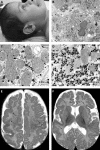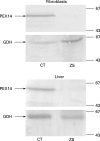Identification of a novel PEX14 mutation in Zellweger syndrome
- PMID: 21686775
- PMCID: PMC3027610
- DOI: 10.1136/bcr.07.2008.0503
Identification of a novel PEX14 mutation in Zellweger syndrome
Abstract
Here we report a patient with Zellweger syndrome, who presented at the age of 3 months with icterus, dystrophy, axial hypotonia, and hepatomegaly. Abnormal findings of metabolic screening tests included hyperbilirubinaemia, hypoketotic dicarboxylic aciduria, increased C(26:0) and decreased C(22:0) plasma levels, and strongly reduced plasmalogen concentrations. In fibroblasts, both peroxisomal α- and β-oxidation were impaired. Liver histology revealed bile duct paucity, cholestasis, arterial hyperplasia, very small branches of the vena portae, and parenchymatic destruction. Immunocytochemical analysis of cultured fibroblasts demonstrated that the cells contain peroxisomal remnants lacking apparent matrix protein content and PEX14, a central membrane component of the peroxisomal matrix protein import machinery. Transfection of fibroblasts with a plasmid coding for wild-type PEX14 restored peroxisomal matrix protein import. Mutational analysis of this gene revealed a genomic deletion leading to the deletion of exon 3 from the coding DNA (c.85-?_170+?del) and a concomitant change of the reading frame (p.[Ile29_Lys56del;Gly57GlyfsX2]).
Figures





Similar articles
-
Identification of a novel PEX14 mutation in Zellweger syndrome.J Med Genet. 2008 Jun;45(6):376-83. doi: 10.1136/jmg.2007.056697. Epub 2008 Feb 19. J Med Genet. 2008. PMID: 18285423
-
Identification of a new complementation group of the peroxisome biogenesis disorders and PEX14 as the mutated gene.Hum Mutat. 2004 Jun;23(6):552-8. doi: 10.1002/humu.20032. Hum Mutat. 2004. PMID: 15146459
-
First Japanese case of Zellweger syndrome with a mutation in PEX14.Pediatr Int. 2015 Dec;57(6):1189-92. doi: 10.1111/ped.12713. Epub 2015 Dec 2. Pediatr Int. 2015. PMID: 26627464
-
Zellweger syndrome: biochemical procedures in diagnosis, prevention and treatment.J Inherit Metab Dis. 1987;10 Suppl 1:33-45. doi: 10.1007/BF01812845. J Inherit Metab Dis. 1987. PMID: 3119940 Review.
-
Zellweger syndrome knockout mouse models challenge putative peroxisomal beta-oxidation involvement in docosahexaenoic acid (22:6n-3) biosynthesis.Mol Genet Metab. 2001 Jan;72(1):1-7. doi: 10.1006/mgme.2000.3101. Mol Genet Metab. 2001. PMID: 11161822 Review.
Cited by
-
A clinical case of Zellweger syndrome in a patient with a previous history of ocular medulloepithelioma.Saudi J Ophthalmol. 2018 Jul-Sep;32(3):241-245. doi: 10.1016/j.sjopt.2017.09.004. Epub 2017 Sep 23. Saudi J Ophthalmol. 2018. PMID: 30224891 Free PMC article.
References
-
- Mannaerts GP, Van Veldhoven PP, Casteels M. Peroxisomal lipid degradation via beta- and alpha-oxidation in mammals. Cell Biochem Biophys 2003; 32: 73–87 - PubMed
-
- Wanders RJ, Waterham HR. Peroxisomal disorders: the single peroxisomal enzyme deficiencies. Biochim Biophys Acta 2006; 1763: 1707–20 - PubMed
-
- Shimozawa N. Molecular and clinical aspects of peroxisomal diseases. J Inherit Metab Dis 2007; 30: 193–7 - PubMed
-
- Steinberg SJ, Dodt G, Raymond GV, et al. Peroxisome biogenesis disorders. Biochim Biophys Acta 2006; 1763: 1733–48 - PubMed
-
- Goldfischer S, Moore CL, Johnson AB, et al. Peroxisomal and mitochondrial defects in the cerebro-hepato-renal syndrome. Science 1973; 182: 62–4 - PubMed
LinkOut - more resources
Full Text Sources
